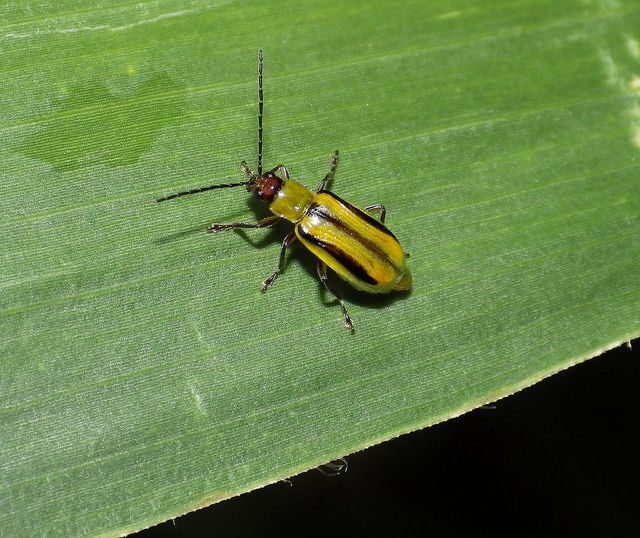A group of researchers from Harvard University has teamed up with Monsanto to develop what could be the next wave of technology to fight pests that have become resistant to crops that are genetically engineered to kill them.
The partnership is based on a technology developed by Dr. David Liu, Professor of Chemistry and Chemical Biology at Harvard, called phage-assisted continuous evolution (PACE) technology. Liu and his team originally developed the technology as a way to create, identify, and evolve optimized proteins up to 100 times faster than previously used methods.
At the time, Dr. Liu’s PACE technology was solely academic, with some ideas about therapeutic applications. But after Dr. Liu met Monsanto’s insect control discovery lead Tom Malvar in Cambridge, where they worked in neighboring laboratory facilities, they decided to investigate whether PACE would be useful for evolving Bt proteins -– proteins derived from the bacterium Bacillus thuringiensis that’s deadly to some pests.
Monsanto researchers wondered whether the PACE technology could assist them with evolving the Bt proteins to bind to an alternative receptor in the insect gut.
“If you could do that, you would restore activity and manage resistance,” Malvar tells AgFunderNews.
Many of Monsanto’s pest-resistant technologies rely upon Bt proteins. These naturally-occurring soil bacteria are used in Monsanto’s corn and cottonseed products to thwart devastating pests. Two particularly troublesome pests are Corn Rootworm and the cotton-devouring Pink Bollworm. The soil bacterium produces proteins that kill certain insects. When the insects ingest a plant containing the Bt protein, the proteins bind to certain receptors in the insect’s gut and eventually kill the insect.
Among the total insect population, a certain number are inherently resistant to certain Bt proteins. Over time, more and more insects can develop a tolerance to Bt protein-based products, rendering them mostly ineffective. The researchers have to develop new renditions of the Bt protein-based products to adjust to the insects’ resistance.
“It can years to change proteins to have the characteristics you desire,” says Malvar. “A researcher will look at a Bt protein and hypothesize which changes they need to make to get a desired outcome. They’ll make those changes, express it, and test it. They use that info for another round of optimization or changes in the Bt protein and this iterative cycle goes on and on. It’s a slow laborious process that can take up to a year.”
PACE may help get ahead of insect’s ability to develop resistance to these technologies.
Essentially, PACE is a bacterial system that uses phages, which are viruses that only infect bacteria. After a phage infects a bacterium, it replicates and eventually destroys it, spreading more phages in the process. The researchers placed the Bt protein into the PACE system where the protein was allowed to continually evolve. This allowed the Bt proteins to accumulate evolutionary mutations, selecting for proteins that are more likely to bind with receptors in the insects’ guts. Instead of waiting for the insect to build up resistance, or having to run the slow laborious process that Malvar described, researchers can get ahead of the insects’ ability to build up resistance to the Bt proteins.
“If you could put the Bt protein into a PACE system where it’s continually evolving, as the protein evolves in the PACE system, it accumulates mutations that favor the interaction of Bt proteins with the receptor,” explains Malvar. “The phages overpopulate in the PACE system and at the end of it, after about a month, you the system has selected for the best binding Bt proteins.”
As resistance develops in the field, the researchers will be able to develop proteins to keep pest resistant products effective.
This technology may sound too good to be true, but Malvar doesn’t see any immediate upper limits to its application or challenges to the development, implementation, and adoption of PACE-based pest control products.
“The way I look at it, this provides us an additional tool to deploy. For instance, the first generation of Bt products that were deployed had one Bt protein that acted in one way against that insect, so the insect only had to become resistant to that one protein,” explains Malva. “The second and third generations had multiple Bt proteins, each working differently against that insect, requiring the insect to become resistant to two-to-three different proteins, which is hard to do.”
PACE may now allow Monsanto to develop new generations that include even more proteins, making it more and more difficult for insects to build resistance.
“Resistance is not impossible, but it extends product lifetime in the field,” he adds.
Now, Monsanto has entered into a limited-term exclusive license agreement with Harvard for the use of this technology for agricultural applications. According to Malvar, they’ve licensed the technology for use in agriculture and are actively using PACE at Monsanto for the development of next-generation insect control products.
Applications could eventually extend beyond Bt and insect control to herbicide tolerance, disease control, and assisting plants with stress, he says.
Overall, Malvar is pleased with the partnership. “It highlights the advantage of private/public sector collaboration. It was very rewarding with exciting results and I’m excited to see how the technology can further embolden the pipeline.
The partners published the results of their recent study in Nature.
Have news or tips? Email [email protected].
Image credit: Sarah Zukoff on Flikr

















Sponsored
International Fresh Produce Association launches year 3 of its produce accelerator